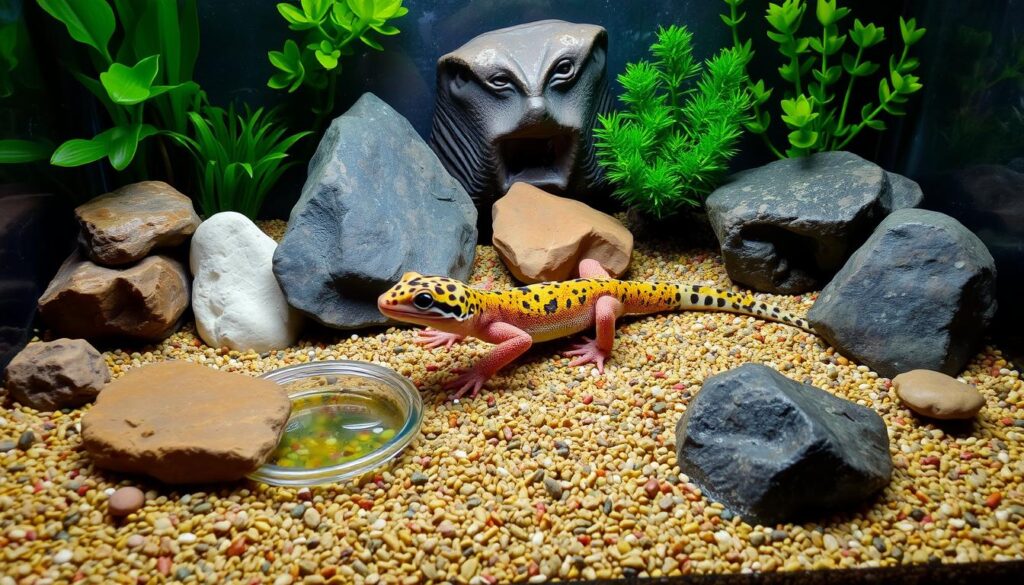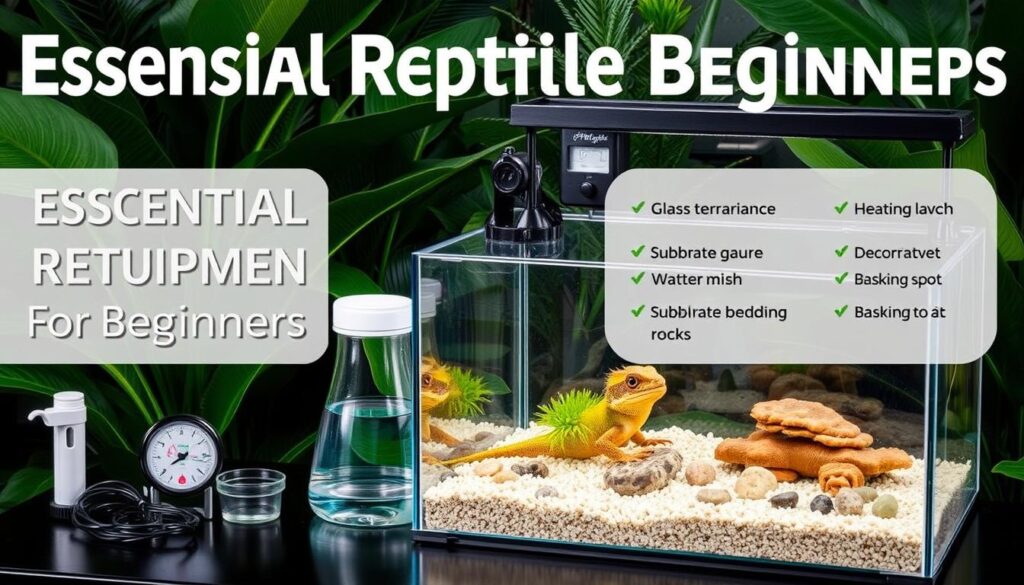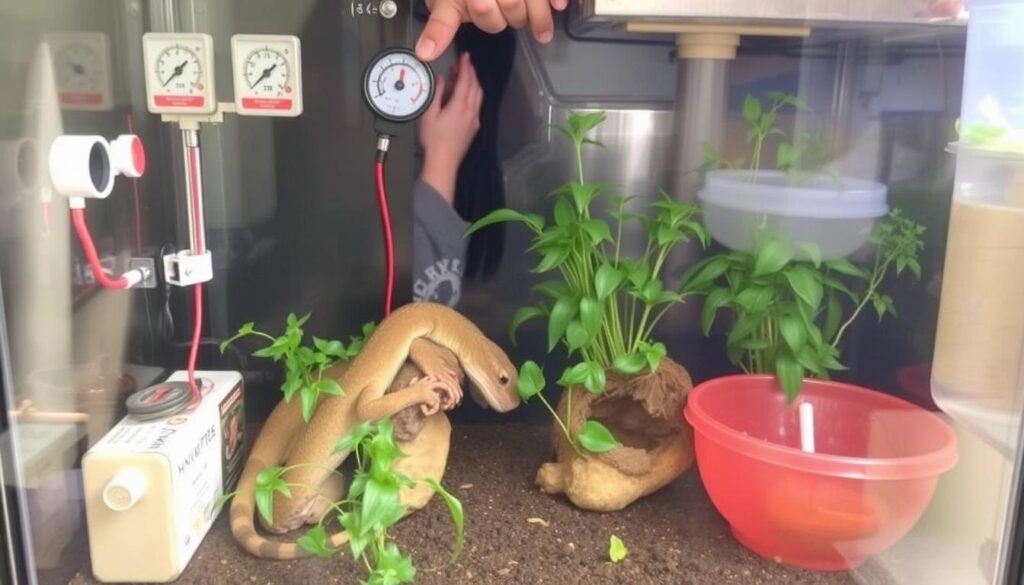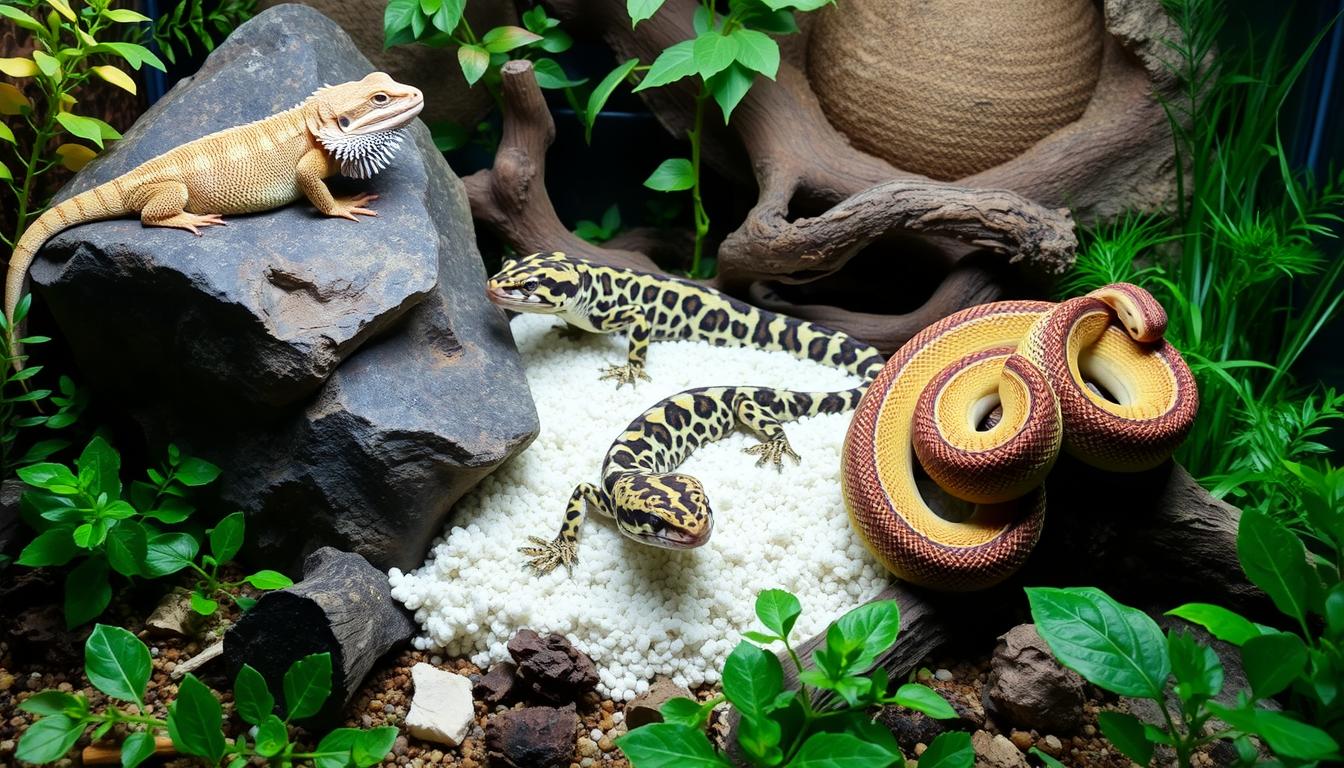Reptiles can be great pets for beginners, offering a unique and rewarding experience. Many people find them to be low-maintenance pets. Beginner reptiles are perfect for those who want to learn about reptile care and handling.
In the United States, reptiles are popular pets. Many species are good for new owners. With the right care, reptiles can do well in a home. Beginner reptiles like leopard geckos are easy to care for. They can be a great first pet, as explained in the leopard gecko care guide.
Key Takeaways
- Reptiles can make great pets for beginners
- Beginner reptiles for pets are relatively low-maintenance
- Proper care and attention are necessary for reptiles to thrive
- Many species of reptiles are suitable for new owners
- Researching and understanding reptile care is essential for a positive experience
- Reptiles can be a unique and rewarding pet choice
Why Reptiles Make Excellent First-Time Pets
Reptiles are often seen as pets for beginners. They are easy to care for because they don’t need much. They are also quiet, so they won’t bother your neighbors.
Bearded dragons and leopard geckos are great for beginners. They are cheap to keep and live a long time. This makes them perfect for those who want a long-term pet without spending a lot.
Benefits of Reptile Ownership
Having a reptile can teach you responsibility. It’s also a fun way to learn. Plus, reptiles are easy to care for, even for busy people.
Common Misconceptions About Reptile Pets
Many think reptiles are slimy or dangerous. But most are harmless and can be great pets. It’s important to learn about their needs before getting one.
What to Consider Before Getting a Reptile
Think about space, diet, and handling before getting a reptile. Some need a lot of room, while others are happy in small spaces. Make sure you can meet their dietary needs and give them the care they need.
Best Beginner Reptiles for Pets: Top Species to Consider
Starting with reptiles can be overwhelming. Choosing the right one is key. For beginners, look at beginner pet reptiles like leopard geckos, bearded dragons, and ball pythons.
These animals are great for new owners. They are small, calm, and easy to care for. Leopard geckos need a dry, well-ventilated space. Bearded dragons are more interactive and need a bit more care.
It’s crucial to know what each reptile needs. This includes their diet, habitat, and special care tips. Picking the right species ensures a happy, healthy pet.
- Leopard geckos: small, low-maintenance, and easy to care for
- Bearded dragons: friendly, interactive, and relatively low-maintenance
- Ball pythons: calm, gentle, and suitable for owners who want a snake
By picking the right reptile, you can enjoy the benefits of pet ownership. You’ll create a happy, healthy home for your new pet.
Leopard Geckos: The Perfect Starter Reptile
For beginners in beginner reptile care, leopard geckos are a great pick. They are small, gentle, and easy to care for. This makes them a top choice for new reptile owners.
Choosing the right home for your leopard gecko is important. They need a space that’s 12 inches wide, 18 inches long, and 12 inches tall. You can use paper towels, carpet, or reptile carpet as the floor. Keeping the temperature right is also key. It should be between 75-85°F during the day and a bit cooler at night.

Housing Requirements
- A well-ventilated enclosure with enough room to move around
- A heat source, like a heat lamp or ceramic heat emitter
- A UVB light to help with calcium and prevent bone disease
Feeding Guidelines
Leopard geckos eat live insects, like crickets, mealworms, and waxworms. A varied diet of these insects keeps them healthy.
Health Monitoring
It’s important to check your gecko’s health often. Watch for signs of illness, such as being very tired, not wanting to eat, or changes in their poop or pee.
Bearded Dragons: Friendly and Interactive Pets
Bearded dragons are a great pick for beginners. They are friendly and love to interact. To keep them happy, you need a big enclosure with the right lighting, heat, and air.
Here are some important things to remember for bearded dragon care:
- Feed them a mix of veggies, fruits, and proteins
- Make their space interesting with rocks, plants, and decorations
- Keep the temperature and humidity just right
By following these tips, you can make your bearded dragon’s life better. For more advice, talk to a reptile expert or check online resources.
Ball Pythons: Gentle Giants for Beginners
Ball pythons are a favorite among beginners because they are calm and have beautiful patterns. They are perfect for those new to reptile pets. To care for them, you need the right enclosure, size, substrate, and temperature.
The enclosure should have a temperature range for your ball python. Use a heat lamp for warmth and a cooler spot for them to cool down. Choose a substrate like aspen or cypress mulch that’s easy to clean. For more tips on caring for pets, check out petsrelax.com.
Handling Tips
Handling ball pythons can help you bond with them. But, do it safely and gently. Hold the snake’s body right and avoid sudden moves. Always wash your hands before and after handling to keep your pet healthy.
Feeding Schedule
Ball pythons eat pre-killed mice or rats. How often you feed them depends on their age and size. Usually, they need food every 7-10 days. Make sure to learn about their specific feeding needs to keep them healthy.
Essential Equipment for Your New Reptile
For beginner reptile care, the right gear is key for your pet’s health. A good beginner reptile setup needs thought on lighting, heating, substrate, and decorations.
Think about what your reptile needs. You’ll need to give them the right light and heat. Also, pick the best substrate and decorations for fun.
Lighting and Heating Options
There are many lighting and heating choices. You can use heat lamps, ceramic heat emitters, or UVB lights. Make sure you know what your reptile needs to get the right light and heat.
Substrate Choices
For substrate, you can choose from sand, gravel, or reptile carpet. Each has its own good points and bad. The best one for your reptile depends on their needs.

Decorations for Enrichment
Decorations like rocks, plants, and branches add fun and stimulation. They also make a natural space. Plus, they offer places to hide and climb.
By picking the right equipment and setting up a great beginner reptile setup, you’ll make your reptile happy and healthy. This ensures a great start with beginner reptile care.
Creating the Perfect Habitat Environment
For many beginner reptile species, a well-designed habitat is key for their health and happiness. When setting up a beginner reptile setup, think about what your reptile needs. This includes humidity, temperature, and lighting.
A good habitat should feel like home for your reptile. It should offer security and keep them stimulated.
Creating a fun and interesting environment is easy. You can add decorations and activities to keep your reptile engaged. Here are some ideas:
- Adding plants or branches to create hiding spots and visual interest
- Incorporating a water feature, such as a shallow pool or waterfall
- Providing a temperature gradient, allowing your reptile to regulate its body temperature
By creating a habitat that meets your reptile’s needs, you can ensure their health and happiness. Always research what your beginner reptile species needs. Then, design a beginner reptile setup that’s both stimulating and comfortable.
Feeding Your Reptile: Basic Nutrition Guide
Proper nutrition is key for your reptile’s health. When feeding your reptile, consider the food type, supplements, and schedules. It’s important to know what your pet needs and give them a balanced diet.
Choosing between live food and prepared food is a big decision. Live food, like crickets and mealworms, gives nutrients and mimics hunting. Prepared food is easier and has a steady nutritional value.
Live Food vs. Prepared Food
- Live food: provides mental stimulation and natural hunting instincts
- Prepared food: convenient and consistent nutritional profile
Supplement Requirements
Many reptiles need supplements for a complete diet. Calcium and vitamin D3 are key for strong bones and preventing diseases.
Feeding Schedules
Feeding times vary by species, age, and size. Learn your pet’s needs and set a feeding schedule. With the right food and care, reptiles can be wonderful pets.
Understanding Reptile Behavior and Body Language
Understanding the behavior and body language of beginner reptile species is key to a strong bond with your pet. Beginner friendly reptiles like bearded dragons and leopard geckos show their feelings clearly. Knowing their signals helps you care for them better.
Look out for signs of stress, courtship, and defense in reptiles. Stress might show as pacing or appetite changes. Courtship can be seen in head-bobbing or arm-waving. Defense behaviors include hissing, growling, or biting.
To grasp your reptile’s behavior and body language, learn about your beginner reptile species. Talking to a vet or experienced breeder can also help. By noticing and acting on your reptile’s cues, you can make a happy, healthy home for your beginner friendly reptiles.
Watching your reptile’s behavior can also spot health issues early. Changes in appetite or stool might mean a health problem. Being alert to these signs and acting fast can prevent serious health issues in your beginner reptile species.
Health Care Basics for Beginner Reptile Owners
Keeping your reptile healthy is key. As a new reptile owner, knowing the basics of beginner reptile care is crucial. A good beginner reptile setup helps prevent health problems.
Reptiles can get sick with things like metabolic bone disease, respiratory infections, and parasites. Taking your reptile to a reptile vet regularly is important. A good diet and clean living space are also key for health.
To find a good reptile vet, ask other owners or check with local vet groups. Knowing what your reptile needs is also important. These steps help you care for your reptile well and keep them happy and healthy.
Preventative Care Measures
- Regular check-ups with a qualified reptile veterinarian
- A balanced and nutritious diet
- Proper hygiene and cleaning of the reptile enclosure
Following these steps can prevent many health problems. Remember, good beginner reptile care and a well-thought-out beginner reptile setup are essential for a happy reptile.
Cost Considerations for New Reptile Owners
Thinking about beginner reptiles for pets means looking at the costs. The first things you need, like the reptile, its home, and food, can cost a lot. You also have to think about ongoing expenses, like vet visits and supplies.
Here are some costs for beginner pet reptiles:
- Purchase price of the reptile
- Equipment, such as enclosures, heating, and lighting
- Food and supplements
- Veterinary care and check-ups
To have a great time with beginner reptiles for pets, plan your budget well. This way, you can give your pet the best care and enjoy the fun of reptile ownership.
Common Mistakes to Avoid When Starting With Reptiles
Starting with reptiles can lead to mistakes that harm your pet’s health. It’s key to know common errors in beginner reptile care. The right environment, including housing, feeding, and handling, is crucial.
Housing Errors
Common housing mistakes include too little space, wrong temperature, and bad ventilation. These can cause stress, illness, and even death in beginner reptile species. To avoid these, research your reptile’s housing needs and provide a suitable space.
Feeding Mishaps
Feeding mistakes, like overfeeding or underfeeding, can harm your reptile’s health. It’s important to know your reptile’s diet needs and feed them well. A balanced diet is vital for your pet’s health, a key part of beginner reptile care.

Handling Mistakes
Handling mistakes, like handling too much or too little, can stress and hurt your reptile. It’s important to learn how to handle your reptile gently and carefully. Avoiding these mistakes helps ensure a happy and healthy bond with your pet, the goal of beginner reptile care and owning beginner reptile species.
Building a Support Network for Reptile Care
Starting out with reptiles can feel like a big task. But, having a support network can really help. Connecting with others who love reptiles, joining online groups or local clubs, and finding mentors can guide you. They can help you understand reptile care better.
It’s key to have a community for beginner friendly reptiles. They can give advice and share their experiences. You can talk about setting up a beginner reptile setup, feeding tips, and how to keep habitats clean. They also offer emotional support when reptile care gets tough.
Here are some ways to build your support network:
- Join online forums and social media groups for reptile care
- Go to local reptile shows and events
- Volunteer at a reptile rescue or conservation group
Having a support network means you can give your reptile the best care. You’ll also have people to turn to for advice or help when you need it.
Legal Considerations and Permits
Before getting a reptile as a pet, it’s key to know the legal stuff. You need to check the laws in your state about owning reptiles. Laws can change a lot from one place to another.
It’s important to follow local laws for beginner pet reptiles. This helps you avoid any trouble. You can talk to local officials or reptile experts to learn about the laws in your area.
State Regulations
Some states have rules about owning certain reptiles. You should ask your local government if you need a permit for your pet. For example, you might need a permit for a ball python or a bearded dragon.
Required Documentation
You might need to show proof of ownership or a health certificate for your reptile. Keeping records of vaccinations and health checks is also important.
Insurance Considerations
Insurance is another thing to think about for reptile pets. Some insurance plans cover reptiles. It’s good to look into this to protect against unexpected vet bills.
Knowing the legal stuff and permits for beginner pet reptiles is crucial. It helps you have a good and safe relationship with your pet. Always put your reptile’s needs first and follow the local laws.
Taking the Next Steps in Your Reptile Journey
Starting your journey as a beginner reptile owner is exciting. But remember, learning is a lifelong process. It’s important to keep learning about reptile care and species. Use books, online courses, and reptile club meetings to grow your knowledge.
Think about diving deeper into reptile care. You could learn about breeding or helping with conservation. Sharing your love for reptiles with others is rewarding. You can volunteer or start a reptile-focused social media account. Every action helps reptiles and teaches people about them.
FAQ
What are some of the best beginner-friendly reptiles?
Top picks for beginners include leopard geckos, bearded dragons, and ball pythons. They are calm, easy to care for, and don’t need much maintenance.
How much space do I need for a beginner reptile?
The space needed varies by species. A 20-gallon tank is a good start. Always check the specific needs of your reptile.
What should I feed my beginner reptile?
Diet varies by species. Most need a mix of live prey and reptile food. Remember to add the right supplements.
How often do I need to handle my beginner reptile?
Reptiles don’t need to be handled often. Handle them gently and only when needed. This helps avoid stressing them out.
What type of lighting and heating do I need for my beginner reptile?
Good lighting and heating are key. Use a heat lamp for the basking area and UVA/UVB lights for calcium metabolism.
How do I know if my beginner reptile is healthy?
A healthy reptile has clear eyes, a clean nose, and smooth skin. Watch for changes in behavior and seek vet advice if needed.
What are some common mistakes to avoid when caring for a beginner reptile?
Avoid wrong housing, bad temperature or humidity, and mishandling. Always follow the care needs of your reptile species.
Where can I find support and resources for caring for my beginner reptile?
Look for online forums, reptile clubs, and pet stores. Talking to other reptile owners can offer great advice and support.

